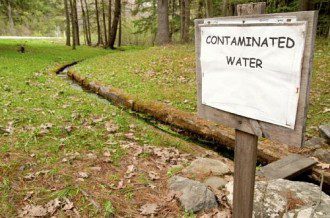Guest Writer for Wake Up World
The United States is considered one of the countries with the safest tap water in the world. There are approximately 155,000 public water systems in the U.S. that provides drinking water to 90% of Americans. The quality of public drinking water in the US is regulated by the Environmental Protection Agency (EPA). The EPA does this by regulating the maximum levels of pollutants and chemicals that are put in drinking water. Our Water sources are vulnerable tocontamination so treatments are necessary to get rid of disease causing pollutants. Water contamination can happen at the source or in the supply system during distribution after the water has already been treated.
[pro_ad_display_adzone id=”110028″]
The fact is each water source contains contaminants that occur naturally and those that result from human activities. Natural contamination of drinking water occurs as the water flows into rivers or streams, filters through soil layers and rocks, or as it sits in lakes.
During these processes the water absorbs or dissolves the substances that it comes into contact with. Depending on its exposure, water changes in terms of its physical parameters and composition.
20 Major Water Contaminants on EPA’s List
The EPA monitors more than 8,000 water contaminants that are common in our drinking water. Here are the top contaminants, their health effects and Federal limits that you need to know about to interpret water quality reports.
1. Barium: Barium is a water contaminant whose exposure leads to increased blood pressure, stomach irritations, and changes in heart beat rhythm and muscle weakness. The maximum Federal acceptable level of this contaminant is 2.0 milligrams per liter of water.
2. Aluminum: Aluminum is not thought to be a contaminant that is harmful to people’s health when its exposure is low. However, long term exposure to this contaminant in the compound such as Aluminum hydroxide (in antacids) or Aluminum chlorohydrate found in most deodorants has been studied and linked to impairment of brain functions and is thought to result in Alzheimer’s disease and breast cancer. The Federal limit for this contaminant is between 0.05 and 0.2 milligrams per liter of water.
3. Beryllium: Beryllium has been identified as a possible human carcinogen and is among the most toxic chemicals known. According to laboratory tests, beryllium exposure can lead to cancer as well as mutation of DNA. The EPA has set a maximum limit of this chemical at 0.004 milligrams per liter.
4. Cadmium: Cadmium is a soluble pollutant whose persistent exposure in low levels can lead to fragile bones, lung damage and kidney disease. The maximum Federal limit of this pollutant is 0.005 milligrams per liter of water.
5. Arsenic: Arsenic is a human carcinogenic compound that is well known. It is a toxic metal whose exposure at any level can lead to damage of the circulatory system as well as the skin. Due to its toxic levels, Federal agencies have set exposure limits at 0.01 milligrams per liter.
6. Silver: Silver is a toxic metal that has been identified to be fatal in human beings when exposure is in high doses. Silver poisoning leads to discoloration of the skin. Federal agencies have set an exposure limits at 0.1 milligrams per liter.
7. Sodium and Chloride: High level of sodium chloride in water causes a salty taste and also affects the growth of plants. Though there are no limits set by Federal agencies for sodium, the limits for chloride are set at 250 milligrams per liter of water.
8. Thallium: This water pollutant leads to liver, intestinal, kidney and testicular tissue damage when exposure is prolonged. Federal agencies have put a limit of 0.002 milligrams per liter of water.
9. Sulfate: Sulfate is a substance that occurs naturally in the earth’s surface. High exposure to sulfate can lead to diarrhea. Federal agencies have limited this substance to 250 milligrams per liter.
10. Chromium: Chromium is a toxic metal whose long term exposure can lead to damage of nerve tissues, kidneys and liver. Exposure beyond the limits set by EPA can lead to ulceration of the skin. Federal agencies set limits of this substance at 0.1 milligrams per liter of water.
11. Fluoride: Fluoride is a compound that was thought to prevent tooth decay for many years. However, overexposure to this compound results to destruction of tooth enamel, joint pain and brittle bones. Federal agencies have set a maximum limit of this compound at 4.0 milligrams per liter of water while the Oregon state have put a lower limit of 2.0 milligrams per liter of water.
12. Lead: Lead is a highly toxic metal that is particularly dangerous for children. In the human body, lead tends to attack the nervous system leading to kidney and brain damage. Federal agencies have set lead limits at 0.015 milligrams per liter.
13. Copper: Copper is another water contaminant that gives drinking water a bitter taste. It is known to cause stains on hair, fixtures and fabrics. When consumed in excessive levels, copper causes vomiting and stomach irritation to people. The Federal Government has put a 1.3 milligram per liter limit to this contaminant.
14. Iron: Iron is a mineral that is required by the human body as it supports the formation of red blood cells that are critical to transportation of oxygen to the body. When taken in excessive quantities, iron can lead to liver diseases such as cancer and cirrhosis. Other ailments associated to iron overload include diabetes mellitus, heart attack, metabolic syndrome, and even neurodegenerative ailments such as Alzheimer’s and Parkinson’s. Federal agencies have put a 0.3 milligrams per liter of water limit.

15. Manganese and Nickel: Both Nickel and Manganese are toxic to the human body. Excessive exposure to manganese is harmful for young children and expectant mothers. According to Federal agencies, the amount of this compound should not exceed 0.05 milligrams per liter of water. Persistent exposure to Nickel can lead to low body weight and liver damage. The Federal limit for Nickel is 0.1 milligram per liter of drinking water.
16. Calcium and Magnesium: Both magnesium and calcium are compounds that are attributed to hardness of water. When ions from these two compounds mix with soap, they result in formations of scum that are insoluble in plumbing fixtures such as water pipes. Calcium is known to be a metal that is abundant in the body and is necessary for the formation of bones and teeth. Furthermore, concentrations of magnesium that exceed 125 milligrams per liter can cause laxative effects. Federal agencies have not put any limits on the amount of calcium or magnesium that each liter of drinking water should have.
17. Uranium and Zinc: Uranium is a substance that occurs naturally and is mildly radioactive. When a person is excessively exposed to this substance they risk developing kidney disease. On the other hand, zinc is a metal that is required by the human body. However, overexposure to this metal can result to anemia. Federal agencies limit exposure to these substances at 0.03 MG/liter for Uranium and 5.0 milligrams per liter of water for Zinc.
18. Molybdenum and Selenium: With excessive ingestion, Molybdenum is a substance that has been linked to ailments such as gastrointestinal disorders, enlarged liver and kidney disorders. Selenium is a nutrient that is essential to the human body at low levels. However, excessive exposure can cause liver, kidney, circulatory and nervous system damage. The EPA limits ingestion of Molybdenum to 40 MG per liter of water and Selenium at 0.05 milligrams per liter.
19. Nitrates/Nitrites: Nitrates/nitrites are nitrogen oxygen chemical units which combines with various organic and inorganic compounds. Once taken into the body nitrates convert into nitrites. Nitrates are greatly used as a fertilizer. Exposure to Nitrates is dangerous for infants who are 6 months old or younger. This substance has adverse effects of infants of this age and can lead to irreversible brain damage and even death. Federal agencies have put a limit of 10 milligrams per liter of water for Nitrate contaminants.
20. Water pH: The ideal drinking water pH level is 7.5. When the pH falls below the 7.0 mark, the water becomes acidic and can lead to corrosion of fixtures and pipes. A pH level that exceeds 8.0 is an indication of alkalinity and may lead to mineral deposits within the pipes. An imbalanced pH can corrode body tissue as well and if left unchecked or imbalanced pH will interrupt all cellular activities and functions in our body.

How to Rid Drinking Water of Contaminants
There are various ways of removing most of the contaminants discussed above from drinking water. They include:
1. Distillation involves evaporation of inorganic contaminants from drinking water. This approach is highly effective in removing contaminants that have a higher boiling point than water such as volatile organic chemicals, nitrates, trace minerals and bacteria. Just like reverse osmosis, the challenge with this method is the fact that it rids water of minerals that are both beneficial and harmful in a non-selective way.
2. Water Filtration and Purification is a process that rids water of contaminants such as lead, chlorine and the by-products associated to it and pharmaceutical product traces like stabilizers and antibiotics. On the other hand, water purification is effective in removing living organisms such as bacteria from water.
3. Reverse Osmosis – This process is much complicated than filtration and purification but highly effective in removing inorganic contaminants discussed above. Reverse osmosis removes all molecular compounds occurring in water that are smaller in size compared to water molecules. This process makes it easy to rid water of salts, harmful minerals, heavy metals such as calcium, manganese, lead and other that are dissolved in water. The only disadvantage with this method is its non-selective approach to removing water contaminants as it rids the water of all minerals, including those that are beneficial to the body.
4. Mineral Concentrates – Adding concentrated ionic sulfate minerals into your water is another way of removing contaminants from drinking water. Adding different types of naturally accruing minerals causes dissolved contaminants in the water to coagulate and become heavier than the water, sinking to the bottom of the container as sediment, making it easy to separate the contaminants from the water. Unlike the other methods of cleaning water, Sulfated Trace Minerals are vital to the human body, so beside cleaning your drinking water, it also restores healthy minerals such as ionic sulfates, magnesium and potassium back into the water.
Further reading from Mark W. Boutwell:
About the author:
“I do not GO through life, I GROW through life!” ~ Mark W. Boutwell
[pro_ad_display_adzone id=”110027″]









